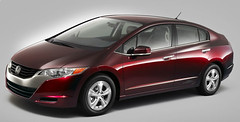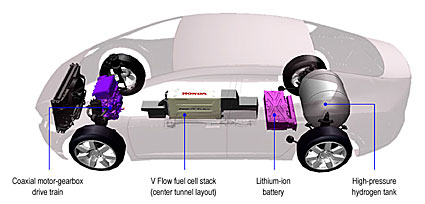Battery & Hydrogen Fuel Cell powered Honda
Posted By RichC on November 23, 2007
 While gasoline hybrid vehicles continue to gain popular, another electrically powered car being introduced by Honda is being test marketed in three California cities. Its the hydrogen fuel cell/lithium battery powered Honda FCX Clarity. Current hybrid vehicles are criticized because they require two propulsion systems making them mechanically complex with batteries yet they still require fossil fuels in comparison to all electric vehicles.
While gasoline hybrid vehicles continue to gain popular, another electrically powered car being introduced by Honda is being test marketed in three California cities. Its the hydrogen fuel cell/lithium battery powered Honda FCX Clarity. Current hybrid vehicles are criticized because they require two propulsion systems making them mechanically complex with batteries yet they still require fossil fuels in comparison to all electric vehicles.
Unfortunately electric cars powered entirely by rechargeable batteries are saddled with very expensive and heavy battery packs that degrade over time and have a limited range; it will be a long time until they can replace an ICE for anything but commuting. Fuel cells, although their current efficiency is a problem, can deliver clean hydrogen powered electricity to an electric motor as long as the vehicles has a tank of fuel. If hydrogen is generated from renewable sources, it is the cleanest of portable fuels and if used in a vehicle along with batteries could be an improvement on all-electric or gasoline hybrid electric vehicles. The Honda FCX Clarity will be an interesting test.

How It Works
A hydrogen fuel cell produces electricity for the vehicle. The fuel cell combines hydrogen, which is stored in a fuel tank onboard the vehicle, with oxygen from the air to make electricity. The electricity then powers the electric motor, which in turn drives the front wheels. Water vapor and heat are the only byproducts.
A fuel cell is made up of a thin electrolyte film wedged between two electrode layers in between two separators. Several hundred layers of these cells are connected in a series.
1. Hydrogen fuel is fed into the anode of the fuel cell. Helped by a catalyst, hydrogen atoms are split into electrons and protons.
2. Electrons are channeled through a circuit to produce electricity.
3. Protons pass through the polymer electrolyte membrane.
4. Oxygen (from the air) enters the cathode and combines with the electrons and protons to form water.
5. Water vapor and heat are released as byproducts of this reaction.
Comments